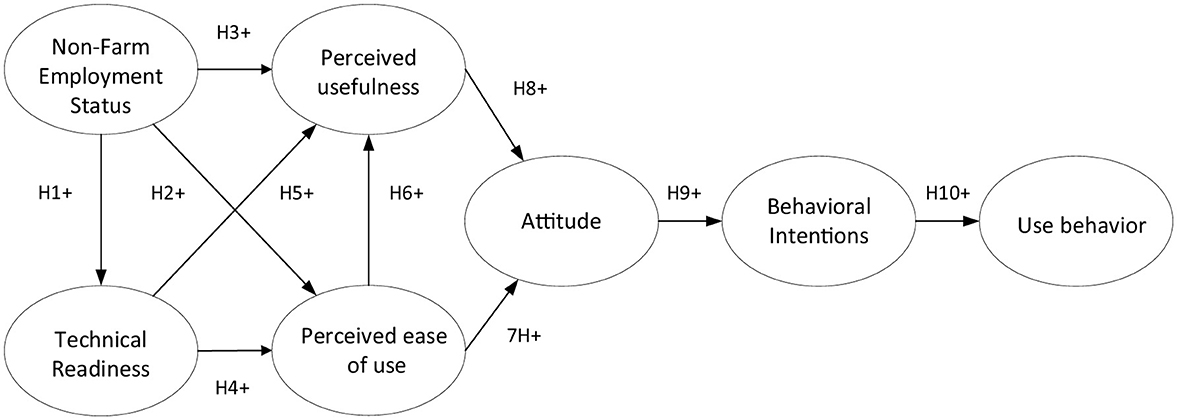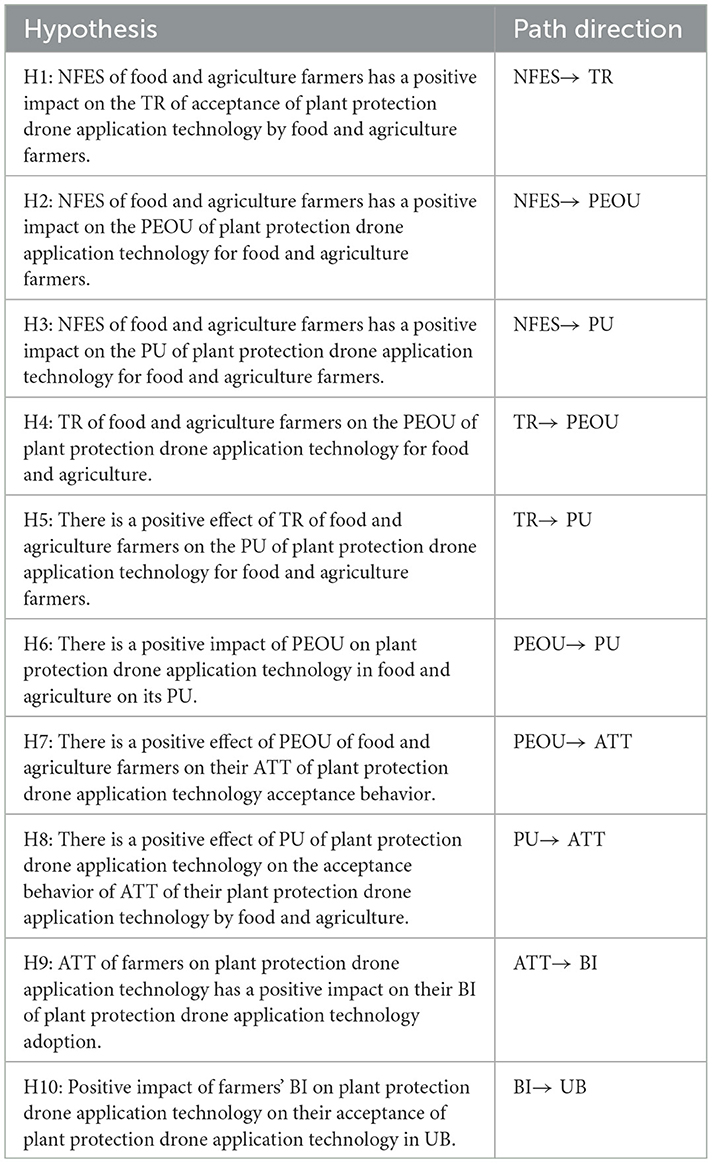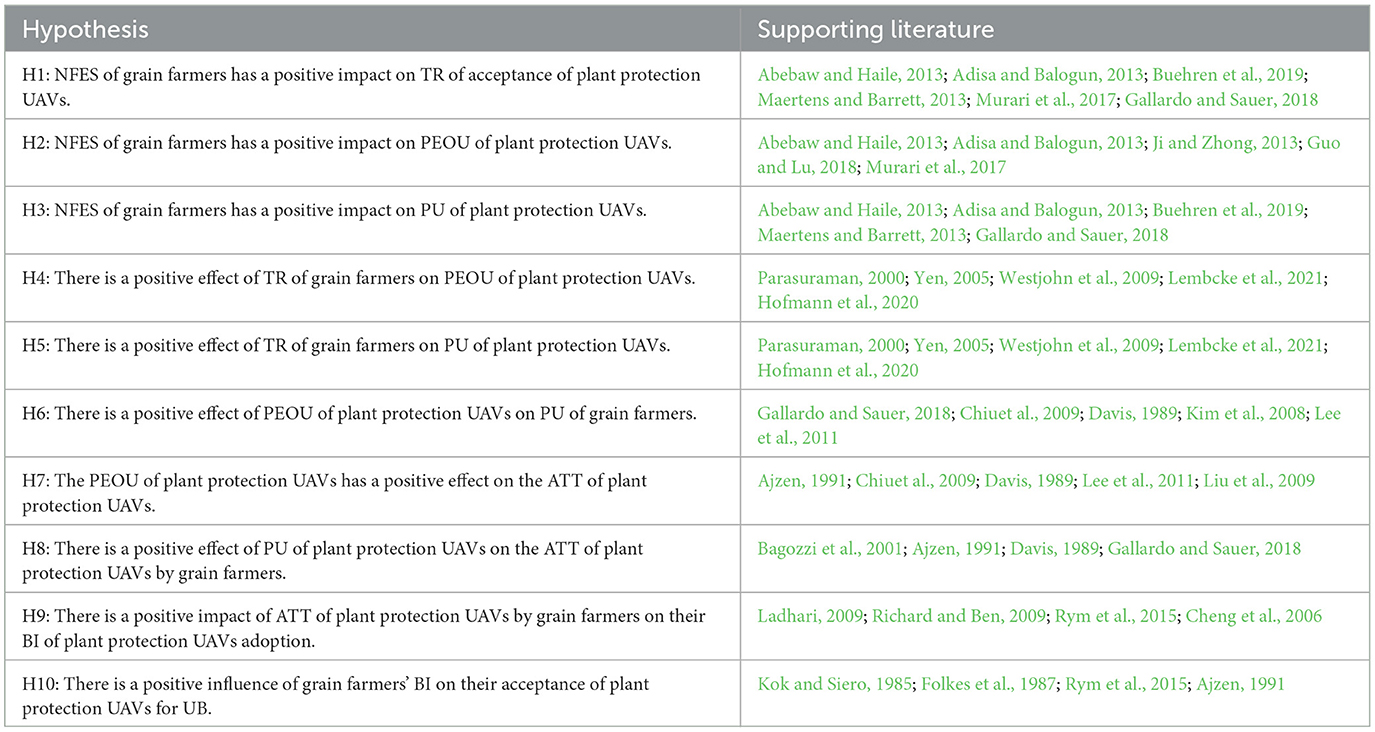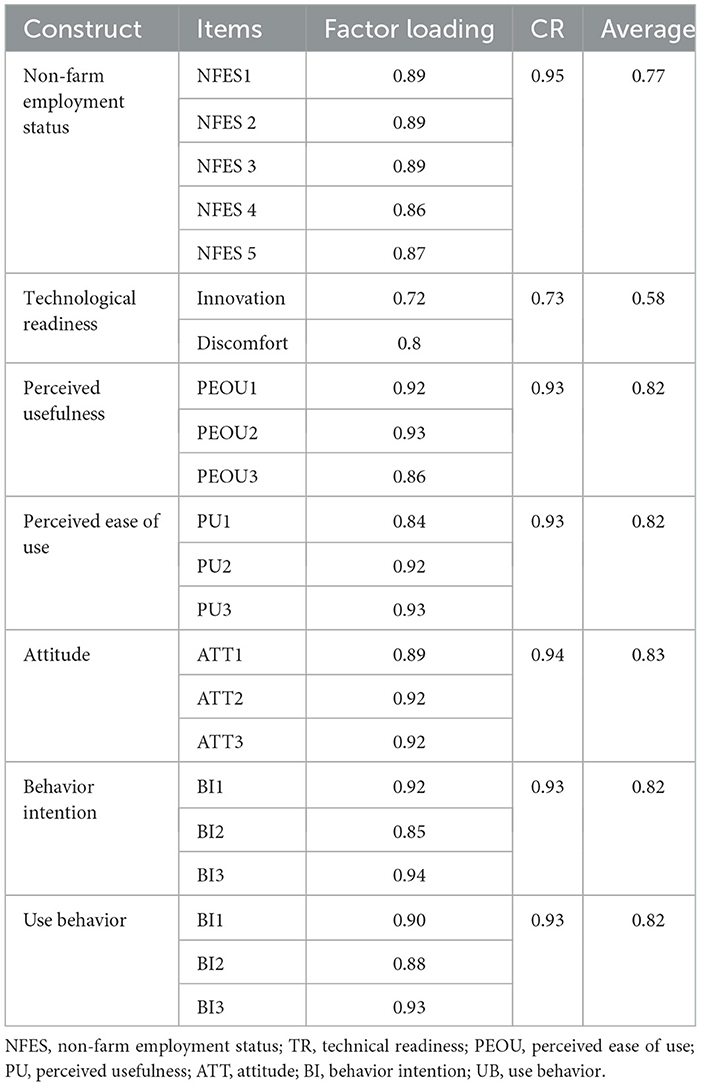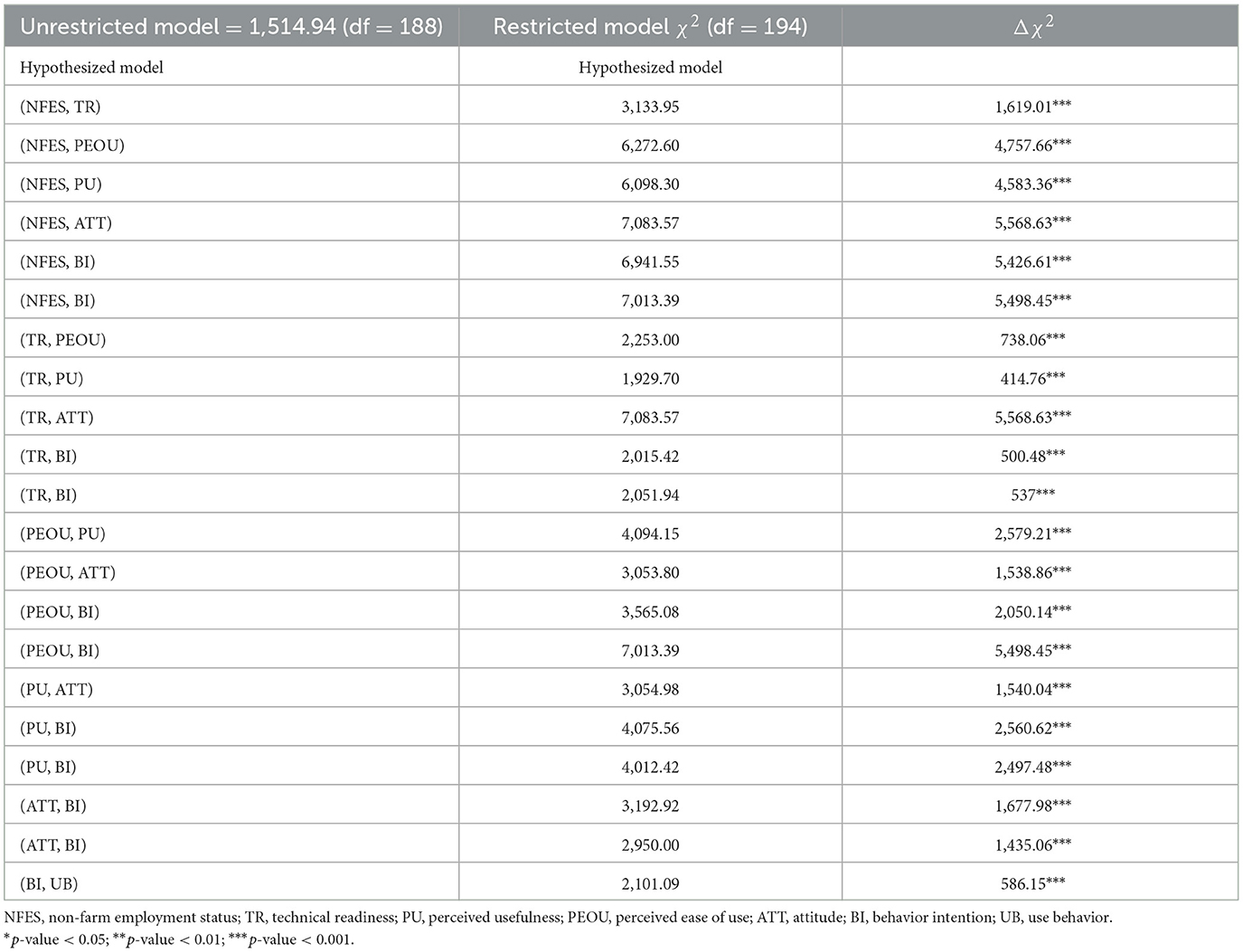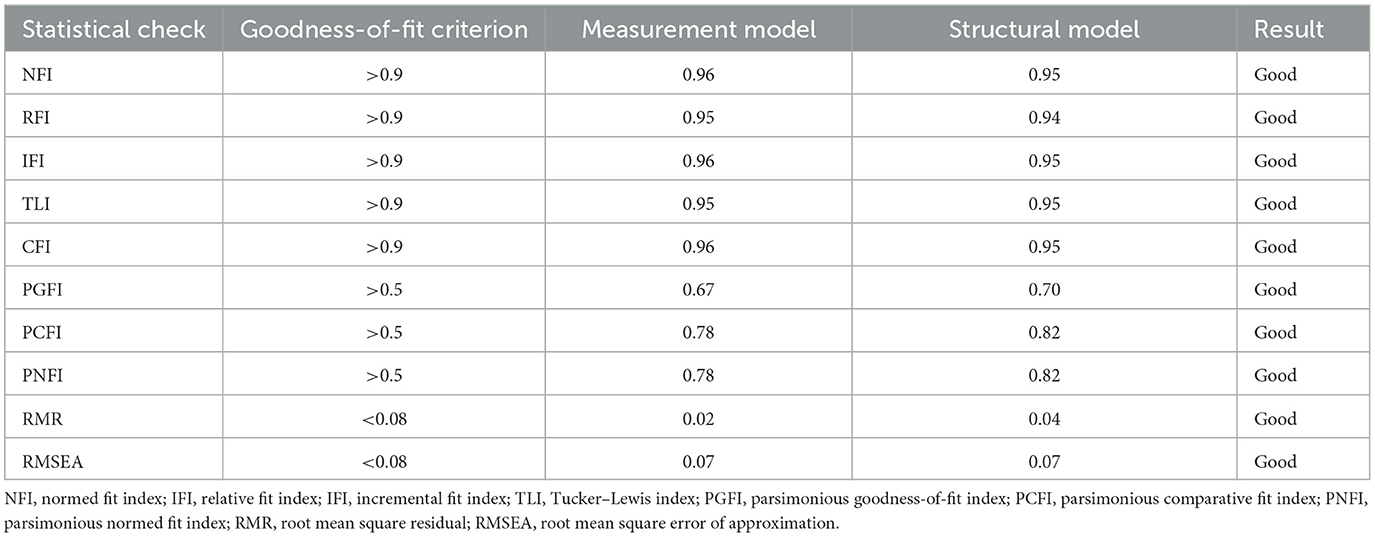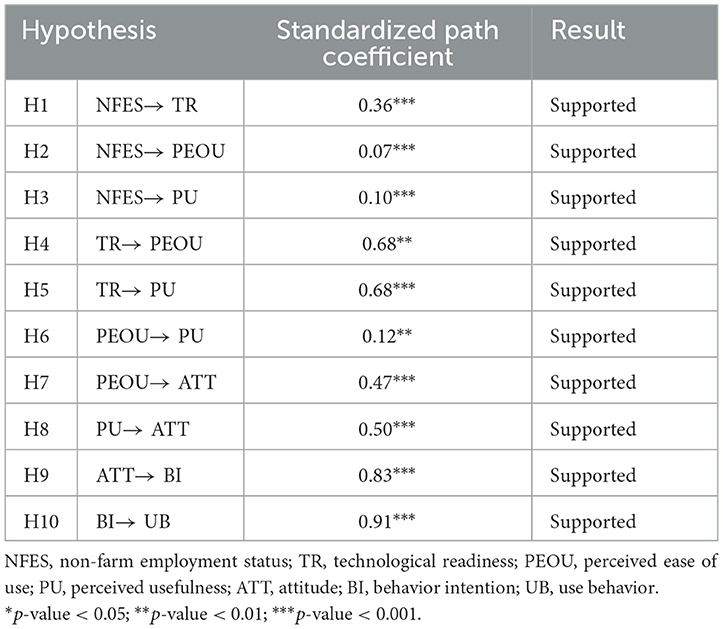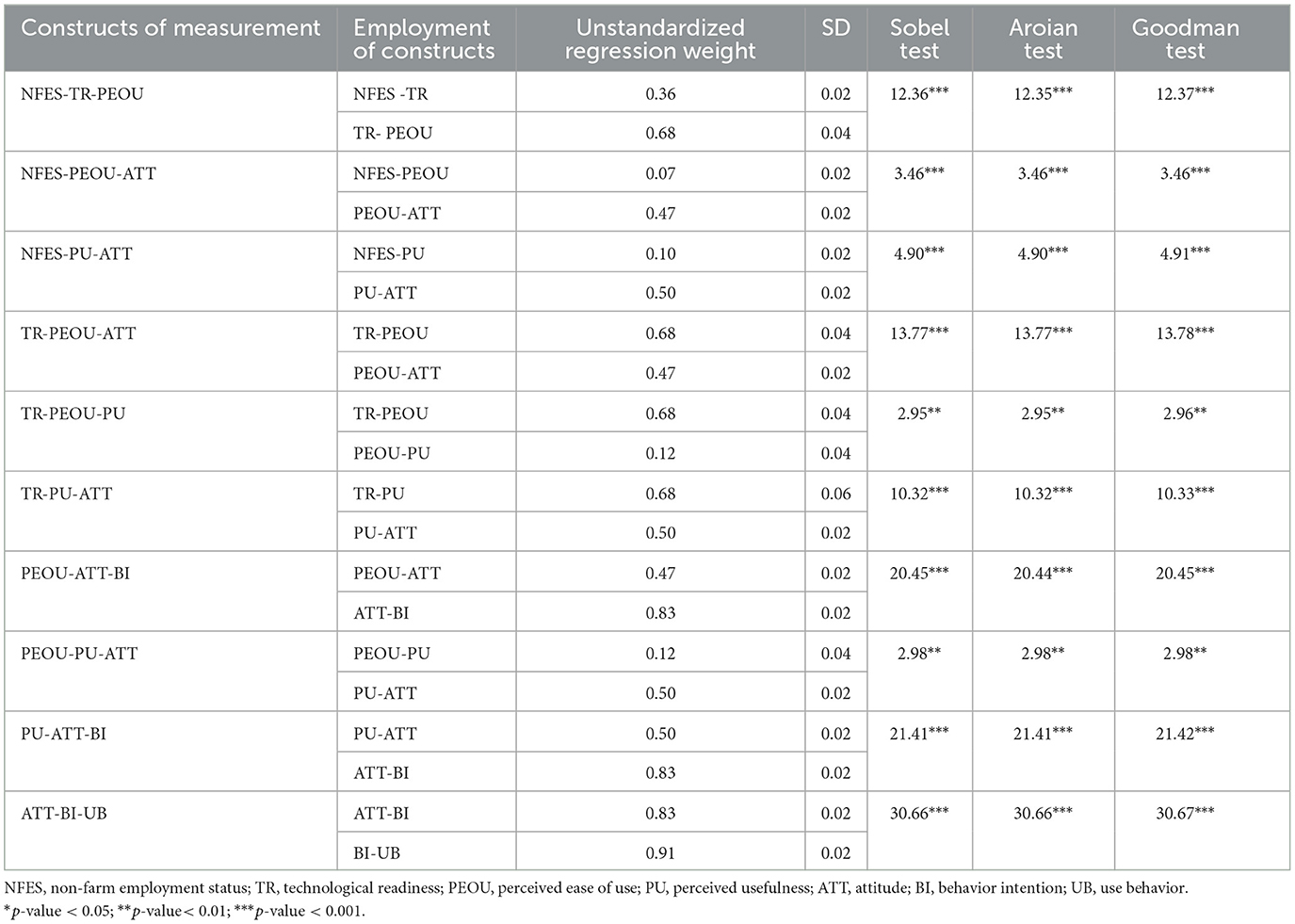- 1Shandong Agricultural University, Taian, Shandong, China
- 2Shandong University of Finance and Economics, Jinan, China
Background: Mechanization and modernization of agricultural development are conducive to the stability of food production and promote increased production and income of food and agriculture. Shandong Province continues to promote pesticide efficiency and reduction in food crop pest control, and plant protection unmanned aerial vehicles (UAVs) have been vigorously promoted and used. However, the application of plant protection UAVs by grain farmers in Shandong Province is uneven, and the use has not achieved the desired effect.
Methods: To study the technology acceptance behavior of plant protection UAVs, this study expands the technology acceptance model (TAM) and constructs a comprehensive theoretical model to explore the factors influencing technology acceptance behavior of plant UAVs among grain farmers.
Results: It was found that the more innovative, comfortable, and easier to use the plant protection UAVs was, the more useful the technology was perceived by the farmers, and the more likely the farmers would accept and use the plant protection UAVs. The better the farmers' attitude evaluation of plant protection UAVs, the greater the intention to use the plant protection UAVs, and the more likely it is to produce actual use behavior.
1 Introduction
The Central Documents of the past years have emphasized the development of agricultural modernization and mechanization, and the No. 1 Central Document for 2022 emphasized the strengthening of the research, development, and promotion of agricultural equipment, such as high-end intelligent and small machinery. Shandong Province also attaches importance to the plant protection UAV application in farmland plant protection operations and vigorously promotes it. The plant protection UAV application is in line with the development of precision agriculture and technology agriculture and has become one of the links of “smart agriculture,” which provides guarantee for modern agriculture and food production, and is conducive to promoting yield of food and income of farmers. The cost of plant protection operations in grain fields can be effectively reduced by using plant protection UAVs, which can save manpower and material resources, improve the efficiency of plant protection in grain fields, and ensure the safety of farmers in plant protection operations. The acceptance behavior of the new technology of plant protection UAVs in agriculture production and the attitude of farmers toward it are worth studying. Therefore, based on the technology readiness theory and technology acceptance model, this study investigated and clarified farmers' acceptance behavior of using plant protection UAVs, addressed the problems in use, and put forward advice to promote the use of plant protection UAVs by farmers. The study also proposed implications to the promotion of plant protection UAVs and its use by farmers and at the enterprise and governmental levels.
2 Literature review and theoretical basis
This section reviewed the relevant research literature, especially the relevant concepts and theoretical foundations based on the literature analysis, to lay the foundation for research design and formulate research hypotheses. The research in this section focuses on the analysis related to farmers' behavior in accepting new agricultural technologies and their understanding of new agricultural technologies.
2.1 Influencing factors on farmers' technology acceptance behavior
Extant literature indicates that individual characteristics, technology-related individual determinants, and external environmental factors constitute the primary determinants of farmers' technology adoption behavior.
2.1.1 Individual characteristics
Farmers' acceptance behavior of plant protection UAVs is influenced by the individual characteristic of farmers. (Murari et al. 2017) pointed out that farmers' group membership and off-farm employment limit the agricultural technology diffusion. (Huang et al. 2020) analyzed the influence of aging and off-farm employment status on farmers' acceptance behavior of soil and water conservation technologies in the Loess Plateau and suggested that aging and off-farm employment status hinder farmers' acceptance of those technologies. Mudemba et al. (2020) suggested that factors such as age, social network, and employment status affect farmers' perceptions and that non-farm employment status has a positive effect on farmers' use behavior of agricultural technologies. The analysis of related literature shows that farmers' acceptance of plant protection UAVs is influenced by their individual characteristic and whether they are full-time farmers. This study attempts to extend technology acceptance model (TAM) by adding non-farm employment status as a variable to the model and to further explore farmers' acceptance behavior on plant protection UAVs.
2.1.2 Technology-related individual determinants
Farmers' technology adoption decisions are modulated by the source, intensity, and structure of their psychological cognition toward technologies (Sui and Gao, 2023). (Huang et al. 2019) demonstrated that farmers' technological perception and perceived value positively influence adoption behavior. The greater the value an agricultural technology provides to farmers, the higher their perceived usefulness of the technology, and the more likely they are to perceive its utility. Moreover, the easier an agricultural technology is to learn, access, or operate, the more likely farmers are to adopt it (Gai et al., 2019).
Scholars have also investigated factors influencing farmers' technology adoption behaviors through behavioral attitudes, perceived behavioral control, and subjective norms toward technologies (Zhang et al., 2020). In-depth research based on the theory of planned behavior (TPB) reveals that farmers' cognition, attitudes, and subjective norms directly affect their behavioral intention to use technologies (Zhou et al., 2024).
2.1.3 External environmental factors
External environmental factors influence farmers' adoption of agricultural technologies through information acquisition channels (Ren and Guo, 2023). (Lwoga et al. 2010) observed that farmers exhibit adoption behaviors after obtaining technical information via interpersonal referrals (e.g., relatives and friends) or media publicity. (Prokopy et al. 2008) argue that farmers' decisions to adopt agricultural technologies are dynamic in nature, influenced by their social network relationships with other farmers. Within social networks, interactions among farmers enable mutual learning and mastery of diverse agricultural technologies, thereby triggering adoption behaviors (Yang, 2018).
With the development of the Internet, new media, and smartphones, farmers' channels for accessing agricultural technical information have diversified (Iraba, 2011). Studies indicate that in Nasarawa State, primary sources of agricultural technical information are agricultural extension agents and agro-input dealers (Salau et al., 2013), and the extent of technology promotion directly affects adoption behaviors (Ataei et al., 2021; Zhou et al., 2020).
Beyond these factors, operational scales, government macro-policies, fiscal subsidies, and farmers' off-farm employment environments also significantly influence farmers' agricultural technology use behaviors (Huang et al., 2016; Jiang et al., 2024; Yang et al., 2025).
2.2 Technology readiness theory
The concept of technical training was proposed by (Parasuraman 2000). Technology maturity reflects the trend of new technology introduction and is an effective means to judge whether consumers have innovative spirits and behaviors or not. (Meuter et al. 2003) reported that technology readiness (TR) indicates the situation in which consumers incline or intend to use innovative technologies for the first time. (Hofmann et al. 2020) in their study of agricultural nanotechnology concluded that technology readiness influences the behavior of technology consumers toward the use of agricultural technology. In this study, technology acceptance was extended into the TAM as an external variable of the TAM to study grain farmers' behavior of using plant protection UAVs.
2.3 Technology acceptance model (TAM)
Many studies show that TAM is a stable analysis model, covering region, time, race, and technology (Lee et al., 2011). TAMs have been applied to business travel (Lembcke et al., 2021) in recent years, smart education (Wang, 2021), and so forth. This study also innovatively extended the technology acceptance model based on theoretical analysis by incorporating technology acceptance and non-farm employment status as personal characteristics of grain farmers as two extension variables to extend the technology acceptance model.
3 Research design
3.1 Model construction and research hypothesis
Technology acceptance model is highly scalable and can incorporate other variables to enhance the explanatory and predictive power of the TAM in different contexts. Perceived ease of use and usefulness are the fundamental determinants of users' acceptance of technology, which not only have an impact on the attitudes and behavioral intentions of grain farmers to use plant protection UAVs but also ultimately affect usage behavior. In this study, an extended structural model was constructed based on the TAM with the addition of non-farm employment status and technology readiness to explore farmers' technology acceptance behavior of plant protection UAVs. The model was constructed based on rational behavior theory, technology readiness theory, and TAM, and the model consisted of non-farm employment status (NFES), technology readiness (TR), perceived ease of use (PEOU), perceived usefulness (PU), attitude (ATT) antecedent variables, and intention to use (BI) and use behavior (UB) explanatory variables. The model was constructed as shown in Figure 1.
The research model in Figure 1 integrates the perspectives of technology acceptance theory and technology readiness theory to form a theoretical research model framework for the acceptance behavior of plant protection UAVs by grain farmers. From the cognitive-behavioral theory, it is clear that the application of plant protection UAVs by grain farmers depends on the personal characteristics of grain farmers (Guo and Lu, 2018). Based on cognitive behavior theory, we believe that the non-farm employment status of farmers will affect their perception of plant protection UAVs. When the non-farm employment status of farmers is good to achieve higher quality employment, they will choose to reduce their costs. As a result, they prefer agricultural machinery and agricultural technology to reduce various costs and save labor when they are engaged in food growing. In view of the above, this study concludes that the acceptance behavior of plant protection UAVs by farmers is influenced by their non-farm employment status. Currently, the non-farm employment status of farmers in Shandong Province is relatively good, and the basic condition of grain fields is also favorable to the promotion of plant protection UAVs. Therefore, this study extends the non-farm employment status into the TAM to study the influence of non-farm employment status on the acceptance behavior of plant protection UAVs of farmers and proposes the following research hypotheses (see Table 1):
• H1: NFES of grain farmers has a positive impact on TR of acceptance of plant protection UAVs.
• H2: NFES of grain farmers has a positive impact on PEOU of plant protection UAVs.
• H3: NFES of grain farmers has a positive impact on PU of plant protection UAVs.
• Influenced by the technical characteristics of plant protection UAVs, when designing the TR model, we retained innovation and discomfort as representatives of positive mentality and negative mentality, respectively. Research shows that when a new technology is released, its adoption is greatly affected by individual differences among consumers, including psychological factors (Yen, 2005). Therefore, hypotheses 4 and 5 are proposed:
• H4: There is a positive effect of TR of grain farmers on PEOU of plant protection UAVs.
• H5: There is a positive effect of TR of grain farmers on PU of plant protection UAVs.
• (Bagozzi et al. 2001) reported that when measuring behavior attitude (ATT), we should not only pay attention to the instrumental components of behavioral ATT, such as useful or harmful and valuable or worthless, but also ignore the emotional components of like or dislike and pleasure or pain. (Gallardo and Sauer 2018) analyzed the influencing factors of the adoption of new agricultural technologies and found that the PU and PEOU both significantly and positively affect farmers' willingness to adopt new technologies. The following hypotheses were formulated in the combined analysis:
• H6: There is a positive effect of PEOU of plant protection UAVs on PU of grain farmers.
• H7: There is a positive effect of PEOU of plant protection UAVs on the ATT of plant protection UAVs of grain farmers.
• H8: There is a positive effect of PU of plant protection UAVs on the ATT of plant protection UAVs of grain farmers.
The individual's ATT on behavior refers to the value judgment of behavior occurrence, which directly affects the behavior intention. (Ladhari 2009) pointed out that technical quality and functional quality have an impact on behavioral intention (BI). (Fanchang et al. 2021) verified applicability of the TAM in new technology adoption, which leads to hypothesis 9:
• H9: There is a positive impact of ATT of plant protection UAVs by grain farmers on their BI of plant protection UAVs adoption.
The study of technology adoption behavior found that user's intention to use is the biggest influencing factor (Rym et al., 2015). Therefore, research hypothesis 10 was formulated:
• H10: There is a positive influence of grain farmers' BI on their acceptance of plant protection UAVs for UB.
Table 1 summarizes the research hypotheses in the design of the theoretical framework of the model. Table 2 summarizes the hypothesis, and the literature backs them up.
3.2 Questionnaire design and data sources
To meet the requirements of content validity, this study reviewed the relevant literature and took several steps to select the items to be included in the questionnaire. First, the researchers translate the selected items in the literature into Chinese. To ensure accuracy, a panel consists of two professors, three food and agriculture workers, and two system designers who are very familiar with plant protection UAV services assisted in reviewing the appropriateness of the Chinese questionnaire translated from the original English plant protection documents. NFES mainly occurs through the personal characteristics of farmers to establish a relationship with the use of the plant protection UAVs. Five-point Likert scale was used to make analysis, ranging from 5 (“highly consistent”) to 1 (“highly inconsistent”). This study took innovation and discomfort as the pre-factors of TR, and the impact of TR on PU and PEOU was tested. By modifying the questionnaire, PU can be used to analyze the user situation of plant protection UAVs to improve the ATT of use. UB mainly refers to the research on the use intention of the respondents to use new technology by (Yong 2021). In this study, it has been modified and applied to the study of grain farmers' use behavior of plant protection UAVs. Table 3 defines these structures and items measured by the questionnaire.
The data of this study were obtained from the field survey. A pretest of the questionnaires was conducted in the previous period. A total of 400 questionnaires were distributed, and 379 questionnaires were returned, with a recovery rate of 94.75%, of which 358 were valid, with an effective rate of 94.46%. Reliability analysis was conducted on the model variables, and the reliability of NFES, TR, PEOU, PU, ATT, BI, and UB was 0.94, 0.910, 0.93, 0.92, 0.93, and 0.94, respectively, which means the questionnaires passed the reliability test. Based on the pre-test, the data were collected from July to September in 2021. More than 220 students, including undergraduate and graduate students, from Shandong Agricultural University conducted a survey on the grain farmers' adoption behavior of plant protection UAVs in 16 cities in Shandong Province in 2021. The survey distributed 2200 questionnaires and 1,866 questionnaires were returned, with a recovery rate of 84.81%, of which 1,558 questionnaires were valid, with an efficiency rate of 83.5%. Table 3 reports the items in the structure of the research model.
4 Methods
The technology acceptance model (TAM) exhibits strong applicability. Most domestic scholars have introduced it into the agricultural domain to analyze farmers' behaviors in adopting agricultural technologies.
First, this model has been employed to investigate farmers' behaviors in using Internet information services. (Cui 2014) analyzed farmers' utilization of agricultural websites based on this theory and posited that the principles of functional usability and information utility should be adhered to in the construction of agricultural websites. (Wen and Sun 2014) conducted research on farmers with different endowments regarding their adoption of information service technologies. The study revealed that perceived usability, trialability, and cost have a more substantial impact on farmers with lower endowments. In contrast, variables such as perceived utility, subjective norms, and network externalities have no significant differential impact on farmers with varying endowments.
Second, the TAM has been utilized to explore farmers' behaviors in adopting new agricultural technologies. (Zheng et al. 2018) carried out research on farmers' cognition and adoption of plant protection drone technology grounded in the TAM. They concluded that the scale of agricultural land is the most significant factor constraining farmers' adoption of plant protection drone technology, and agricultural production cooperative organizations play a crucial role in the promotion of plant protection drones. (Gallardo and Sauer 2018) extended and adjusted the TAM to study farmers' behaviors in using water-saving irrigation technologies. The findings indicated that perceived utility and perceived usability impose internal constraints on farmers' technological cognition, while technological utility and subjective norms have a positive influence on farmers' behaviors in adopting new agricultural technologies. (Chen et al. 2020) constructed a multi-objective utility function for farmers to analyze the impact of farmers' cognition on their adoption of ecological agriculture models. (Zhang et al. 2021) found that perceived usability, perceived utility, and environmental responsibility awareness have a notable impact on farmers' behaviors. Moreover, perceived usability and perceived utility act as mediators in external variables such as social influence and result demonstration.
Drawing on the above research experiences, this study, building upon previous studies, takes the TAM as the foundation and incorporates external variables to expand the model. The aim is to study the adoption behaviors of grain farmers in Shandong Province regarding the use of plant protection drone technology for pesticide application. Through the method of empirical testing and analysis using structural equation modeling, this study clarifies the logical relationships of the influencing variables in the adoption behaviors of grain farmers regarding plant protection drone technology for pesticide application. This not only addresses the limitations of existing research but also provides corresponding recommendations to facilitate the better promotion and application of plant protection drone technology for pesticide application.
Structural equation modeling emerged in the 1960s and is known as one of the three major developments in statistics recently. Due to the continuous enhancement of computing power, it has been widely applied in the field of social science research. It consists of three matrix equations. The expression is as follows:
In Equations 1–3, η is an endogenous latent variable, referring to the pesticide application behavior of VAVs for agricultural and plant protection; ξ is an exogenous latent variable that refers to non-agricultural employment status, technical readiness, perceived ease of use, perceived usefulness, attitude antecedent variables, and intention to use (BI) and usage behavior. The structure of the model is shown in Figure 1. ζ is the random error term of the structural equation, reflecting the part of η that cannot be explained in equation (1); B is the coefficient matrix of endogenous latent variables, describing the mutual influence between endogenous latent variables η ; Γ is the coefficient matrix of the exogenous latent variable, describing the impact of exogenous latent variable ξ on endogenous latent variable η ; yis an endogenous observation variable, which reflects the pesticide application behavior indicators of agricultural plant protection drones;xis an exogenous observational variable that reflects the state of non-agricultural employment, technological readiness, perceived ease of use, perceived usefulness, attitude antecedent variables, and indicators of intention to use and use behavior;Λyis a coefficient matrix composed of the factor loads of yon η ; Λx is a coefficient matrix composed of the factor loads of x on ; ε and δ are measurement error vectors for endogenous and exogenous observation variables, respectively.
5 Analysis of data and results
5.1 Descriptive statistical analysis
The descriptive statistical analysis can clarify the basic sampling data distribution related to the distribution of the sample corresponding to the sample and facilitate a preliminary understanding of the sample characteristics. The sample was surveyed by grain farmers, including full-time and part-time farmers. A total of 1,558 valid questionnaires have been collected in this survey, among which the topographical landscape of the interviewees' location was dominated by plains, accounting for 72.3% of the total sample size, and the dominance of plains landscape was more favorable to the promotion of plant protection UAVs and increased the acceptance behavior of grain farmers toward it; 881 (56.55%) interviewees were male, and 677 (43.45%) were female. About age, 3.27% of the respondents were ≤ 20 years old, 40.63% were between 21 and 30 years old, 16.17% were between 31 and 40 years old, 23.88% were between 41 and 50 years old, and 16.05% were older than 51 years old; in terms of marital status, 65.73% of the respondents were married, and 34.27% were unmarried. In terms of education level, 39.67% of the respondents were educated at junior high school level or below, 21.95% were at senior high school level, 30.17% were at college level, and 8.22% were at undergraduate level or above. The distribution of education level shows that most of the farmers are not highly educated.
(Hair et al. 2010) put up that a sufficient number of samples are required for estimation by maximum likelihood (e.g., a minimum of 100 samples is the most conservative requirement). If the scale of samples was small, it could lead to failure or improper structural equation modeling results. In this study, the number of samples collected was adequate and met the sample requirements for structural equation modeling analysis.
5.2 Measurement and model analysis
To ensure the robustness of the data and the validity of the model, several statistical techniques were applied. First, the reliability of the constructs was tested using Cronbach's alpha and composite reliability (CR) as these indicators can verify the internal consistency of the measurement items. Second, confirmatory factor analysis (CFA) was conducted to evaluate convergent and discriminant validity, which is necessary before structural model testing. Structural equation modeling (SEM) is particularly suitable for questionnaire-based research with complex theoretical frameworks such as the extended TAM applied in this study. Accordingly, in this study, factor loading was calculated, and a value exceeding 0.5 was used as the evaluation standard. If a measured factor load fails to reach this value, the measurement is not representative and is therefore deleted. Otherwise, it will be retained. In this study, the measurement model is used to verify the factor load of various measurements. The load factor of construction measures should exceed 0.5 and then to be retained. The recommended value should exceed 0.7 for comprehensive reliability (Nunnally, 1978). The results of this study show that the comprehensive reliability of each structure reaches 0.7, indicating that these structures have the required reliability (Table 4). Furthermore, the construct measurement in this study has been modified for use based on domestic and foreign research. The measurements used meet the content validity standard. Therefore, this study has content validity. In addition, it is also necessary to make the factor load of indicators in the structure statistically significant, the structural reliability exceeds 0.7, the average variance (AVE) extracted from each structure exceeds 0.5, and the research model exhibited convergent validity (Fornell and Larcker, 1981).
The constructs of NFES, TR, PU, PEOU, ATT, BI, and behavior comply with the convergent validity conditions put forth by (Fornell and Larcker 1981) (Table 4). Thus, these results support convergent validity for each construct.
These tests are consistent with the procedures of confirmatory factor analysis, which ensure the measurement model achieves both reliability and validity before testing the structural relationships.
Discriminant validity refers to the differences between the two structures in the research framework. The discriminant validity test of the two constructs reveals the unrestricted mode and restricted mode's difference (χ2). When the χ2 value is >3.84 (p-value = 0.05), it indicates significant validity. The restricted and unrestricted mode's gaps, χ2, are far more than 3.84; therefore, the research has discriminant validity (Table 5).
Next, this study evaluates the goodness of fit of the structural model once the reliability and validity requirements are met. According to the average measurement items' value in each dimension in this study, the NFES scale was summarized into two factors. This “unit-weighted factor score” can perform better, as reflected by its higher reliability and community, greater parsimony, and fewer chances for residuals to be correlated or dual loadings to emerge. Nine fitness indicators were ultimately used (Table 6).
5.3 Structural model analysis
SEM was then employed to test the hypothesized relationships. Compared with traditional regression methods, SEM is more appropriate for this study because it can simultaneously estimate multiple relationships among latent variables, handle mediating effects, and account for measurement errors. Those features make SEM particularly suitable for analyzing the extended TAM framework proposed in this research. After confirming the adequacy of the measurement model, SEM with AMOS 26.0 was employed to test the hypothesized paths. The normed fit index (NFI) is 0.95. The relative fit index (RFI) is 0.94. The incremental fit index (IFI) is 0.95. The Tucker–Lewis index (TLI) is 0.95, the CFI is 0.95, the parsimonious goodness-of-fit index (PGFI) is 0.67, the parsimonious comparative fit index (PCFI) is 0.78, the parsimonious normed fit index (PNFI) is 0.78, the root mean square residual (RMR) is 0.04, and the root mean square error of approximation (RMSEA) is 0.07 (Table 5). The results from the structural model support this association for all models. This study used structural equation modeling to test the 10 hypotheses. The hypothesized paths from NFES, TR, PU, PEOU, ATT, BI, and UB were significant according to structural equation modes (SEMs) for using plant protection UAVs (Table 7). Figure 2 shows that the results of hypothesis testing supported all the hypothesized relationships.
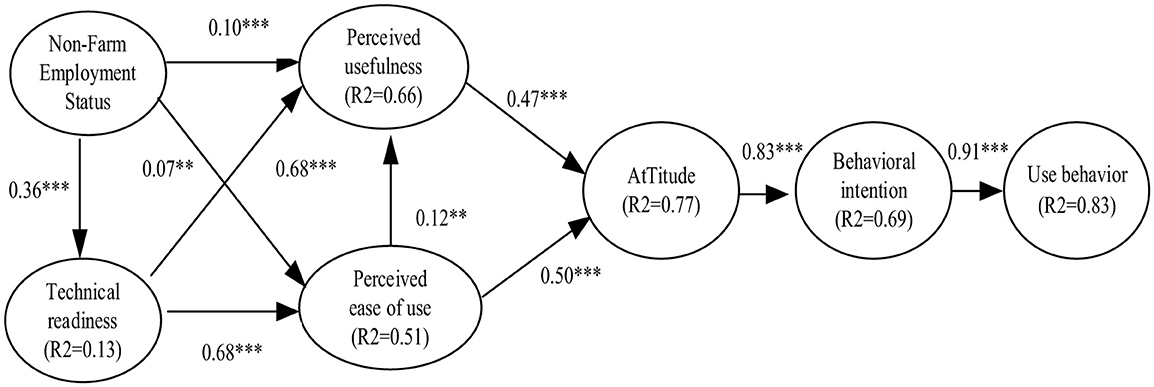
Figure 2. Standardized solution of structural modeling analysis. NFES, employment quality; TR, technological readiness; PEOU, perceived ease of use; PU, perceived usefulness; ATT, attitude; BI, behavior intention; UB, use behavior. *p-value < 0.05; **p-value < 0.01; ***p-value < 0.001.
5.4 Hypothesis testing
This research conducts the mediating effect test proposed by (Sobel 1982). To estimate/assess mediation effects, 10 equations of indirect effects were employed (Table 8). Specifically, NFES-TR-PEOU was used to examine the indirect effect of TR. NFES-PEOU-ATT, TR-PEOU-ATT, and TR-PEOU-PU were used to test the indirect effects of PEOU. TR-PU-ATT, PEOU-PU-ATT, and NFES-PU-ATT were used to test the indirect effects of PU. PEOU-ATT-BI and PU-ATT-BI were used to test the indirect effects of ATT, and ATT-BI-UB was used to test the indirect effects of BI. The test results indicate that the mediating path was significant (p-value < 0.05), according to the mediation effect (Table 8).
6 Discussion
As shown in the previous section, NFES and TR determined the behavior of grain farmers using plant protection UAVs through PEOU, PU, ATT, BI, and UB. This study also confirms the exploratory, applied, and predictive nature of the proposed model through structural equation modeling. According to the results, this section discusses the academic contributions and management implications and suggests future research directions and ideas.
First, BI positively influenced the UB (β = 0.91) of the use of plant protection UAVs by grain farmers, with a total variance of 83% of the explanatory power. The use of plant protection UAVs by grain farmers must have a strong BI, and it can be promoted by increasing the BI of grain farmers toward the application technology. How to improve the intention of using plant protection UAVs is the key to the whole chain, which contributing to improving agricultural production efficiency and saving a large amount of labor, while protecting farmers' health and promoting the shift to non-agricultural industries.
Second, the effect of ATT on BI was significant and positive (β = 0.83). The results suggest that the ATT of plant protection UAVs can be changed by increasing the publicity of plant protection UAVs, increasing the training of plant protection UAVs, increasing the subsidies for the purchase of plant protection UAVs and their application technology by grain farmers, and developing easy-to-operate plant protection UAVs to increase the intention of grain farmers to use it.
Third, there was a significant positive effect of PU on ATT (β = 0.47). This indicates that the greater the value of the use of plant protection UAVs, the more likely it is to change the attitude of grain farmers toward it. Therefore, we should actively expand the use value of plant protection UAVs.
Fourth, PEOU had a positive and significant effect on PU (β = 0.12) and a considerable effect on ATT (β = 0.50). This indicates that the easier the plant protection UAVs is to use, the more the grain farmers feel that the technology is useful to them and thus develop a positive attitude toward the technology. In addition, the test for mediating effects showed that PEOU had a significant mediating effect on PU, ATT, BI, and UB through PU. Therefore, to promote the use of plant protection UAVs by grain farmers, the designers and developers of plant protection UAVs should try to integrate different interfaces, such as smartphones and tablets, rather than just using apps or adding voice services, to simplify the use of technology system from the end-user's perspective.
Fifth, the effect of TR on PEOU was positive and significant (β = 0.68); the direct effect of TR on PU was also significant (β = 0.68). Therefore, TR is an important indicator to promote the use of plant protection UAVs by grain farmers. TR includes innovation and discomfort; therefore, to enhance the tendency of grain farmers to use plant protection UAVs, it is necessary to provide knowledge and skill training to enhance the innovation spirit and ability to use technology development of grain farmers, so as to enhance the TR of grain farmers and make them more inclined to accept and use plant protection UAVs.
Sixth, there was a significant positive effect of NFES on TR (β = 0.36), a significant direct effect of NFES on PEOU (β = 0.07), and a significant effect of NFES on PU (β = 0.10). In this study, the non-farm employment status of grain farmers was included in the study of the use behavior of plant protection UAVs, and the results not only confirmed the human development theory that “farmers make choices that maximize personal or family interests” but also creatively analyzed the impact of non-farm employment status on the adoption of new agricultural production technologies by grain farmers from the perspective of farmers' employment and part-time work. Therefore, improving the non-farm employment status of farmers is an important driver for improving technology readiness and promoting the use of plant protection UAVs among farmers. Farmers with better non-farm employment status were more educated and more receptive to new things; they were able to realize the importance of plant protection UAVs, were more likely to learn and operate the technology, and were more financially capable of purchasing or renting plant protection UAVs.
7 Conclusion
In this study, we constructed a comprehensive analytical framework to study the behavior of grain farmers in using plant protection UAVs by using non-farm employment status, technology readiness, perceived ease of use, perceived usefulness, attitude, behavioral intention, and use behavior as variables. It was found that the more innovative, comfortable, and easier to use the plant protection UAVs was, the more useful the technology was perceived by the farmers, and the more likely the farmers would accept and use the plant protection UAVs. The better the farmers' attitude evaluation of plant protection UAVs, the greater the intention to use the plant protection UAVs, and the more likely it is to produce actual use behavior. In addition, non-agricultural employment status has a strong positive effect on technology readiness, perceived ease of use, and perceived usefulness; therefore, improving non-agricultural employment status and technology readiness of grain farmers is an important prerequisite for promoting the use of plant protection UAVs by grain farmers. The causal relationships found in this study can provide reference for enterprises to develop and promote plant protection UAVs, guidance for social service organizations on how to better carry out their services, and reference for policy formulation by relevant government administrative departments.
Data availability statement
The raw data supporting the conclusions of this article will be made available by the authors, without undue reservation.
Ethics statement
The studies involving humans were approved by Animal Ethics Committee, Shandong Agricultural University. The studies were conducted in accordance with the local legislation and institutional requirements. The participants provided their written informed consent to participate in this study.
Author contributions
WZ: Conceptualization, Formal analysis, Funding acquisition, Investigation, Methodology, Supervision, Writing – original draft, Writing – review & editing. HL: Data curation, Formal analysis, Investigation, Writing – original draft. ZX: Investigation, Methodology, Project administration, Supervision, Writing – original draft. JH: Data curation, Investigation, Resources, Software, Visualization, Writing – review & editing. MX: Resources, Software, Validation, Visualization, Writing – review & editing.
Funding
The author(s) declare that financial support was received for the research and/or publication of this article. This research was sponsored by 2021 Shandong Province Social Science Planning special project – Think tank high-end talent cultivation research topic “Study on the Construction of Agricultural and Rural Modernization Index System and its Promotion Path in Shandong Province” (Project No. 21CKRJ05).
Conflict of interest
The authors declare that the research was conducted in the absence of any commercial or financial relationships that could be construed as a potential conflict of interest.
Generative AI statement
The author(s) declare that no Gen AI was used in the creation of this manuscript.
Any alternative text (alt text) provided alongside figures in this article has been generated by Frontiers with the support of artificial intelligence and reasonable efforts have been made to ensure accuracy, including review by the authors wherever possible. If you identify any issues, please contact us.
Publisher's note
All claims expressed in this article are solely those of the authors and do not necessarily represent those of their affiliated organizations, or those of the publisher, the editors and the reviewers. Any product that may be evaluated in this article, or claim that may be made by its manufacturer, is not guaranteed or endorsed by the publisher.
References
Abebaw, D., and Haile, M. G. (2013). The impact of cooperatives on agricultural technology adoption: empirical evidence from Ethiopia. Food Policy 48, 82–91. doi: 10.1016/j.foodpol.2012.10.003
Adisa, R. S., and Balogun, K. S. (2013). Impact of improved technologies on small-scale soybean production: empirical evidence from Benue state, Nigeria. Pak. J. Agric. Sci. 50, 305–310.
Ajzen, I. (1991). The theory of planned behavior. Org. Beh. Hum. Decis. Process. 50, 179–211. doi: 10.1016/0749-5978(91)90020-T
Ataei, P., Gholamrezai, S., Movahedi, R., and Aliabadi, V. (2021). An analysis of farmers' intention to use green pesticides: the application of the extended theory of planned behavior and health belief model. J. Rural Stud. 81, 374–384. doi: 10.1016/j.jrurstud.2020.11.003
Bagozzi, R. P., Ue, H. M., and VanLoo, M. E. (2001). Decisions to donate bone marrow: the role of attitudes and subjective norms across cultures. Psychol. Health 16, 29–56. doi: 10.1080/08870440108405488
Buehren, N., Goldstein, M., Molina, E., and Vaillant, J. (2019). The impact of strengthening agricultural extension services on women farmers: evidence from Ethiopia. Agric. Econ. 50, 407–419. doi: 10.1111/agec.12499
Chen, X., Huang, W., Qi, Z., and Feng, Z. (2020). Cognition, adoption intensity and income effect of ecological farming and breeding models: evidence from the rice–shrimp co-culture model in the middle and lower reaches of the Yangtze River. Rural Econ. China 71−90.
Cheng, C.-Y., Chen, J.-S., and Lin, C.-Y. (2006). The impact of website quality on customer satisfaction and purchase intention: perceived playfulness and perceived flow as mediators. Inf. Manag. 43, 411–422. doi: 10.1016/j.im.2006.02.001
Chiu, C. M., Lin, H. Y., Sun, S. Y., and Hsu, M. H. (2009). Understanding customers' loyalty intentions towards online shopping: an integration of technology acceptance model and fairness theory. Behav. Inform. Technol. 28, 347–360. doi: 10.1080/01449290801892492
Cui, Y. (2014). Research on the evaluation of the development status of agricultural enterprise websites in Henan Province. Agric. Netw. Inform. 89−92, 111. doi: 10.1038/lsa.2014.99
Davis, F. D. (1989). Perceived usefulness, perceived ease of use, and user acceptance of information technology. Mis Q. 13, 319–340. doi: 10.2307/249008
Fanchang, P., Zhong, X., and Li, H. (2021). Farmers' adoption of sustainable agricultural technologies: evidence from China. Sustainability 13:12345. doi: 10.3390/su132212345
Folkes, V. S., Susan, K., and Graham, J. L. (1987). A field study of causal inferences and consumer reaction: the view from the airport. J. Consum. Res. 13, 534–539. doi: 10.1086/209086
Fornell, C., and Larcker, D. F. (1981). Evaluating structural equation models with unobservable variables and measurement error: a comment. J. Marke. Res. 18, 39–50. doi: 10.1177/002224378101800104
Gai, H., Yan, T., He, K., and Zhang, J. (2019). Farmers' adoption of conservation tillage technologies from the perspective of social embeddedness: evidence from survey data of 668 households in Hebei, Anhui, and Hubei provinces. Resour. Environ. Yangtze Basin 28, 2141–2153. doi: 10.48550/arXiv.2304.12749
Gallardo, R. K., and Sauer, J. (2018). Adoption of labor-saving technologies in agriculture. Ann. Rev. Resour. Econ. 10, 185–206. doi: 10.1146/annurev-resource-100517-023018
Guo, G., and Lu, Q. (2018). Research on the impact of TAM's intrinsic perception on the adoption of different water-saving irrigation technologies by farmers: a case study of Zhangye, Gansu Province. Chin. J. Agric. Resour. Reg. Plann. 39, 129–136.
Guo, R. L., Liu, Z. Y., and Chen, J. H. (2020). Farmers' part-time industrialization, land fragmentation and socialized service of agricultural machinery – taking Jiangxi province as an example. Res. Agric. Modernization 41, 135–143. doi: 10.13872/j.1000-0275.2019.0108
Hair, J. F., Black, W. C., Babin, B. J., Anderson, R. E., and Tatham, R. (2010). Multivariate Data Analysis: A Global Perspective. Upper Saddle River: Pearson, 45–47.
Hofmann, T., Lowry, G. V., Ghoshal, S., Tufenkji, N., Brambilla, D., Dutcher, J. R., et al. (2020). Technology readiness and overcoming barriers to sustainably implement nanotechnology-enabled plant agriculture. Nat. Food 1, 416–425. doi: 10.1038/s43016-020-0110-1
Huang, X., Wang, L., and Lu, Q. (2019). Farmers' cognition, government support, and the adoption of soil and water conservation technologies: evidence from a survey of 1,152 households in the Loess Plateau. Arid Land Resour. Environ. 33, 21–25.
Huang, X. H., Lu, Q., Wang, L., Cui, M. S., and Yang, F. (2020). Does aging and off-farm employment hinder farmers' adoption behavior of soil and water conservation technology in the Loess Plateau? Int. J. Clim. Change Strateg. Manag. 12, 92–107. doi: 10.1108/IJCCSM-04-2019-0021
Huang, Z., Zhong, Y., and Wang, X. (2016). The impact of different policies on farmers' pesticide application behavior. China Popul. Resour. Environ. 26, 148–155. doi: 10.3969/j.issn.1002-2104.2016.08.020
Iraba, D. (2011). Determinants of improved rice variety adoption in Eastern Uganda (M.Sc. Thesis). Makerere University, Kampala, Uganda.
Ji, Y. Q., and Zhong, F. N. (2013). Nonagricultural employment and utilization of agricultural machinery services for farmers. J. Nanjing Agric. Univ. 13, 47–52.
Jiang, L., Huang, H., and He, K. (2024). The impacts of technical training and economic subsidies on farmers' diffusion behaviors of bio-pesticide application technology. China Rural Surv. 163–184. doi: 10.48550/arXiv.2404.14580
Kim, T. G., Lee, J. H., and Law, R. (2008). An empirical examination of the acceptance behaviour of hotel front office systems: an extended technology acceptance model. Tour. Manage. 29, 500–513. doi: 10.1016/j.tourman.2007.05.016
Kok, G., and Siero, S. (1985). Tin recycling: awareness, comprehension, attitude, intention and behavior. J. Econ. Psychol. 6, 157–173. doi: 10.1016/0167-4870(85)90019-4
Ladhari, R. (2009). Service quality, emotional satisfaction, and behavioural intentions. Mana. Serv. Qual. 19, 308–331. doi: 10.1108/09604520910955320
Lee, Y. C., Li, M. L., Yen, T. M., and Huang, T. H. (2011). Analysis of fuzzy decision making trial and evaluation laboratory on technology acceptance model. Expert Syst. Appl. 38, 14407–14416. doi: 10.1016/j.eswa.2011.04.088
Lembcke, T. B., Herrenkind, B., Nastjuk, I., and Brendel, A. B. (2021). Promoting business trip ridesharing with green information systems: a blended environment perspective. Transp. Res. Part D Transp. Environ. 94, 1–18. doi: 10.1016/j.trd.2021.102795
Liu, S. H., Liao, H. L., and Pratt, J. A. (2009). Impact of media richness and flow on e-learning technology acceptance. Comput. Educ. 52, 599–607. doi: 10.1016/j.compedu.2008.11.002
Lwoga, E. T., Ngulube, P., and Stilwell, C. (2010). Information needs and information seeking behaviour of small-scale farmers in Tanzania. Innovation 2010, 82–103. doi: 10.4314/innovation.v40i1.60088
Maertens, A., and Barrett, C. B. (2013). Measuring social networks' effects on agricultural technology adoption. Am. J. Agric. Econ. 95, 353–359. doi: 10.1093/ajae/aas049
Meuter, M. L., Ostrom, A. L., Bitner, M. J., and Roundtree, R. (2003). The influence of technology anxiety on consumer use and experiences with self-service technologies. J. Bus. Res. 56, 899–906. doi: 10.1016/S0148-2963(01)00276-4
Mudemba, R., Taruvinga, A., and Leocadia, Z. (2020). Determinants of adoption of indigenous knowledge (IK) based technology in handicrafts among rural women of amathole, south Africa: a double hurdle model approach. Afr. J. Sci. Technol. Innov. Dev. 13, 1–8. doi: 10.1080/20421338.2020.1799535
Murari, S., Raju, G., and Michael, K. (2017). Farmer's participation in extension programs and technology adoption in rural Nepal: a logistic regression analysis. J. Agric. Educ. Extens. 23, 351–371. doi: 10.1080/1389224X.2017.1323653
Parasuraman, A. (2000). Technology readiness index (TRI) a multiple-item scale to measure readiness to embrace new technologies. J. Serv. Res. 2, 307–320. doi: 10.1177/109467050024001
Prokopy, L. S., Floress, K., Klotthor-Weinkauf, D., and Baumgart-Getz, A. (2008). Determinants of agricultural best management practice adoption: evidence from the literature. J. Soil Water Conserv. 63, 300–311. doi: 10.2489/jswc.63.5.300
Ren, Z., and Guo, Y. (2023). The impact of environmental regulation and social capital on farmers' adoption of low-carbon agricultural technologies. J. Nat. Resour. 38, 2872–2888. doi: 10.31497/zrzyxb.20231112
Richard, J. H., and Ben, T. K. (2009). The technology acceptance model: its past and its future in health care. J. Biomed. Inform. 43, 159–172. doi: 10.1016/j.jbi.2009.07.002
Rym, B., Olfa, B., and Ben M'BM. (2015). Determinants of e-learning acceptance: an empirical study in the tunisian context. Am. J. Ind. Bu. Manag. 3, 307–321. doi: 10.4236/ajibm.2013.33036
Salau, E. S., Saingbe, N. D., and Garba, M. N. (2013). Agricultural information needs of small holder farmers in central agricultural zone of Nasarawa State. J. Agric. Ext. 17, 113–121. doi: 10.4314/jae.v17i2.15
Sobel, M. E. (1982). Asymptotic confidence intervals for indirect effects in strucutural equation models. Sociol. Methodol. 13, 290–312. doi: 10.2307/270723
Sui, Y., and Gao, Q. (2023). Farmers' endowments, technology perception and green production technology adoption behavior. Sustainability 15:7385. doi: 10.3390/su15097385
Wang, H. M. (2021). Application of smart-phone apps by Chinese college students in learning English. Sino-US Engl. Teach. 18:5. doi: 10.17265/1539-8072/2021.05.004
Wen, J., and Sun, H. (2014). Comparative analysis of information service technology adoption behavior among households with different endowments. Math. Pract. Theory 44, 79–88.
Westjohn, S. A., Arnold, M. J., Magnusson, P., Zdravkovic, S., and Zhou, X. Y. (2009). Technology readiness and usage: a global-identity perspective. J. Acad. Market. Sci. 37, 250–265. doi: 10.1007/s11747-008-0130-0
Yang, Y., Si, W., Zhou, X., and Feng, X. (2025). Traditional practice and policy incentives: an analysis of farmers' adoption behavior of relay strip intercropping technology. J. Agrotechnical Econ. 49−67. doi: 10.13246/j.cnki.jae.2025.06.001
Yang, Z. (2018). Aging, social networks, and farmer' adoption of green production technologies: Evidence from household survey data in six provinces of the Yangtze River Basin. China Rural Surv. 44−58.
Yen, R. H. (2005). An attribute-based model of quality satisfaction for internet self-service technology. Serv. Ind. J. 25, 641–659. doi: 10.1080/02642060500100833
Yong, J. (2021). Determinants of smallholder farmers' adoption of sustainable intensification practices: evidence from China. Agronomy 11:2098. doi: 10.3390/agronomy11102098
Zhang, J., Yan, T., and Jiang, X. (2021). Value perception, environmental responsibility awareness and farmers' straw resource utilization: an extended technology acceptance model multi-group analysis. Chin. J. Agric. Resour. Reg. Plann. 42, 99–107. doi: 10.7621/cjarrp.1005-9121.2021.04.014
Zhang, Y., Tian, Y., and Wang, Y. (2020). Farmers' adoption of conservation tillage technologies from a cognitive perspective: evidence from Heilongjiang Province in the black soil region of Northeast China. Res. Agric. Modernization 41, 275–284. doi: 10.13872/j.1000-0275.2020.0003
Zheng, S., Chen, X., and Wang, Z. (2018). Land scale, cooperative membership and the cognition and adoption of plant protection UAV technology: a case study of Jilin Province. J. Agrotech. Econ. 92−105.
Zhou, G., Wang, B., and Li, X. (2024). Research on the factors influencing farmers' adoption of plant protection UAV technology: an empirical analysis based on the theory of planned behavior. Shanxi Agric. Econ. 33–37, 42.
Keywords: technology acceptance model, technology readiness, plant protection UAVs, use behavior, agriculture, structural equation model, grain farmers
Citation: Zhang W, Li H, Xia Z, Hu J and Xin M (2025) Grain farmers' technology acceptance behavior of plant protection UAVs. Front. Sustain. Food Syst. 9:1583949. doi: 10.3389/fsufs.2025.1583949
Received: 26 February 2025; Accepted: 25 August 2025;
Published: 12 September 2025.
Edited by:
Utpal Kumar De, North Eastern Hill University, IndiaReviewed by:
Xiaoqiang Han, Shihezi University, ChinaGraha Prakarsa, Universitas Informatika dan Bisnis Indonesia, Indonesia
Copyright © 2025 Zhang, Li, Xia, Hu and Xin. This is an open-access article distributed under the terms of the Creative Commons Attribution License (CC BY). The use, distribution or reproduction in other forums is permitted, provided the original author(s) and the copyright owner(s) are credited and that the original publication in this journal is cited, in accordance with accepted academic practice. No use, distribution or reproduction is permitted which does not comply with these terms.
*Correspondence: Zhaomin Xia, MjAwNjU1ODRAc2R1ZmUuZWR1LmNu
†These authors share first authorship
 Wuwei Zhang
Wuwei Zhang Hao Li1†
Hao Li1† Zhaomin Xia
Zhaomin Xia